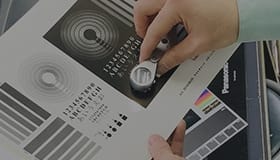Product overview
UV DVC ink is UV curable screen ink widely applicable to optical media such as CD-R and polycarbonate substrates.
- UV Ink

Application
- Label printing of Optical discs in general
-
Automobile, Motorcycle
-
Home Appliance (IoT)
-
Smartphone, Tablet, Smart watch
-
Sensor
-
Game
-
Others
Features, Function
- Prevents “block errors” caused by ink
- Amine-free
- Low odor, low skin irritation, safe and easy to handle ink
- Multi color setting
Substrate
- Various CD/DVD, Polycarbonate substrates
- PC
Dilution
- Not required(Use RE-806 REDUCER within 5% when required)
Catalyst, Promoter mixing
- SM-510 ADDITIVE 0 to 3%(If curability of ink is slow)
Promoter
- SM-269 DEFOAMER 0 to 1%(if foaming or repelling occurs)
- UV Thixotropic Agent 0 to 2%(to increase viscosity)
Recommended cleaner
- Screen Cleaner L2
- Applicable to machine cleaning with less hazardous glycol ether types(Glycol ether type cleaning may not be suitable for some types of stencil emulsions, so please be sure to test it beforehand.)
Mesh
- T 300 to 420 mesh(Coverage is 50 to 60m2/kg)
Drying, Curing
- Accumulated energy: about 380mJ/cm2, Peak power:400mW/cm2(Eye Graphics UV integral light counter)
- Two 80W/cm Metal halide lamps, lamp height 15 cm, belt speed 10m/min
Standard colors
-
000 MEDIUM
-
011 MATT BASE
-
121 SCARLET
-
160 SCARLET
-
177 OPAQUE RED
-
221 YELLOW
-
240 LIGHT YELLOW
-
277 OPAQUE REDDISH YELLOW
-
525 ORANGE
-
581 MAGENTA
-
617 WHITE
-
659 WHITE
-
797 GREEN
-
821 VIOLET
-
911 BLACK
Caution
- Checking adhesion before production: Adhesion may change depending on the substrates, processes, and printing. Be sure to check the adhesiveness before mass production printing.
- Ink shelf life: stable for 12 months from shipping date
Safety
- UN No.: Not classified in the definition
- UN Classification: Not classified in the definition
Handling
- Use safety gloves and eyeglasses to protect skin and eyes. If the ink comes in contact with skin, wash with soap and plenty of water (or lukewarm water) and consult with a doctor.
- Containers should be closed tightly after use and stored in a cool and dark place.
- SDS is available upon request. Please request a copy and read it carefully before handling the products.
Resistance
| Test item | Test Condition | Test results |
|---|---|---|
| Adhesion | JIS K 5600-5-6(cross-cut), 1mm interval 6×6、 cellophane tape and peel | 0(no peel) |
| Pencil Hardness | JIS K 5600-5-4(pencil),Weight 750g, Hardness which does not make scar. | 2B |
| Heat | 80℃ 500 hrs. check appearance and peel off | No defect |
| Hot-cold cycling | JIS K 5600-7-4 5 cycles、80℃(4h)~25℃(1h)~-40℃(4h) Check appearance and peel off | No defect |
| Humidity(1) | JIS K 5600-7-2(Continuous condensation) 60℃ 85%RH 500 hrs. check appearance and peel off | No defect |
| Humidity(2) | JIS K 5600-7-2(Continuous condensation) 55℃ 98%RH 500 hrs. check appearance and peel off | No defect |
| Cold | -40℃ 500 hrs. check appearance and peel off | No defect |
| Alcohol | Gakushin scrub tester, cotton ethanol soaked, weight 500g, 3 back and forth, check peel off | Almost no whitening |
| Over printing | Overprinting of 6 to 7 colors, check appearance and peel off | No defect |
| Bend | 80℃ 90%RH 150 hrs. warpage change of CD prints | Tilt angle less than 0.2 |
| Haze on PC(substrate) | Effect on PC substrate of uncured prints at 60℃ | No defect |
| Haze on PS(case) | Effect on PS substrate of uncured prints at 60℃ | No defect |
| Sticking to OPP film | After enclosing in non-woven fabrics, store for 24 hrs. at 40℃ 90%RH, check appearance. | No defect |
| High speed printing | Disc printing press, compatible to printing speed, Tact time 0.6 sec to 2.0 sec | Compatible |
Test Condition
- Test condition 【120W/cm 1 Metal halide lamp, Tact speed 2.0 sec.(30pcs/min)】 【T 380】 【Substrate: Dummy CD, CD-R, DVD】
- Above resistance test results are measured results in our laboratory and they are not guaranteed values.
- Information contained in this catalog may change without prior notice.
FAQ
-
What is screen printing?
-
Screen printing is a type of stencil printing which uses a technique of duplicating the image from a design made on mesh stencils.
When printing ink goes through the mesh, it transfers the image onto the substrate material. Other than air and water, any substrate materials are printable. Not only flat surfaces, but also curved, specially shaped, and molded products are suitable for screen printing.
- Related inks

